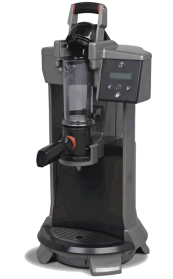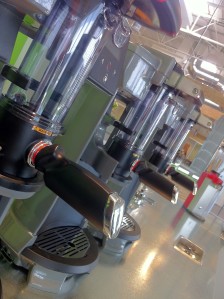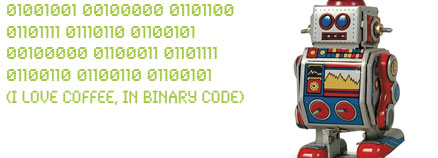You are currently browsing the category archive for the ‘Equipment’ category.
“Welcome to Episode 5 of there is a Reason for Everything which makes this the Empire Strikes Back of coffee blogs.” – Clinard
Lets start this week by going back in time for a second, please keep your hands and arms inside the DeLorean at all times.

best way to enjoy kyoto iced coffee without waiting 10 hours is time travel.
In the 1850’s the coffee industry had two problems, they couldn’t control the temperature of water well enough to brew coffee properly and they couldn’t filter the grounds from the brew mixture properly so most coffee had the consistency of mud.
Enter the siphon, or vacuum pot (“vac pot” for short) – an 1850’s German designed coffee brewer that is the most entertaining to watch of all the brew methods in our shop. We have a blog that goes into more detail about this machine’s history. But lets get back to the future, and address the question at hand:
Why have I never seen this thing before? And why use it, just for the coolness factor?
 The coolness factor is only a peripheral benefit that is secondary to the quality in the cup. Just like with everything we have talked about, it is what ends up in the cup that is the most important.
The coolness factor is only a peripheral benefit that is secondary to the quality in the cup. Just like with everything we have talked about, it is what ends up in the cup that is the most important.
As to why you might not have seen one, the siphon has reemerged in America after being trumped by countertop auto-drip machines, stovetop brewers, and instant coffee. Because (much like Walmart, fast food, and sweat pants) these methods have dominated this country purely out of convenience.
Now that we are experiencing a coffee quality renaissance here in America, the siphon is making a comeback. In Japan, where specialty coffee is taken very seriously (and they don’t like Walmart), the siphon is as widely used as espresso machines here in America.
All coffee brew methods fall along a spectrum with what we call “Body” on one side and “Flavor Clarity” on the other. The Hario V-60 falls in the middle, the Trifecta between the middle and body side and the siphon is at the extreme side of flavor clarity. The siphon is special because it presents some of the most delicate flavors in the coffee. It effectively draws some flavor oil but few coffee solids so while the coffee’s viscosity is lighter, the ability to detect even the most subtle flavor notes is amplified. It’s like when you remove the white noise so you can hear the notes of song more clearly. The peach in my Guatemala La Soledad and the key lime in my Kenya pop when brewed on the siphon. It’s beautiful! I absolutely love the siphon. Even at 160 this old guy is keeping up with all the young guys on our bar. Like the Slayer.
 The Slayer was designed and built by the fine folks from Slayer Espresso in Seattle, Washington in the good ol’ US of A. It is refreshing to see a company venture off and experiment with the age-old and ever-so complicated process of brewing espresso.
The Slayer was designed and built by the fine folks from Slayer Espresso in Seattle, Washington in the good ol’ US of A. It is refreshing to see a company venture off and experiment with the age-old and ever-so complicated process of brewing espresso.
What did the Slayer do that was so different? And why did you pick this machine when there are so many machines out there that are cheaper, and make good espresso?
Slayer bucked the norm and created a machine that allows the trained barista to affect brew pressure at various points in the brew process – commonly referred to as “pressure profiling.” What this means is we can custom design a shot profile to highlight what is best about a particular espresso and mute what is offensive or undesirable. Because even with amazing coffee, if prepared improperly, then it can taste less than good. With the Slayer, we have the ability to alter the shot in ways that simply aren’t possible with traditional espresso machines. That is why I can put some pretty amazing single-origin shots on the menu that would generally not be obtainable on standard espresso machines – at least without some sacrifice. We can also make many adjustments at the machine to hone in the extractions on our Show No Mercy espresso blend. We have a great blog on the Slayer if you want to read more about this killer machine: It’s Called Slayer.
You might wonder why we chose this machine when there are other machines out there that utilize pressure profiling in some way or that can pull single-origin Espresso just fine without being a Slayer. I would love to get into detail about that, just comment on this blog with your questions, or hit us up on twitter or facebook.
I would talk about our Japanese cold water drip iced coffee brewer, dubbed the “Kyoto” or the Hario Fretta iced coffee system, but again we previously created a blog that does this wonderfully. If you have more questions about those methods, please just comment on the blogs and we will happily answer them.
All of this “stuff” is meant for nothing other than creating the freshest brewed coffee and is part of the equation as to why our coffee is as good as it is – the other part of the equation is the ingredients.
Support Good Coffee
Jeff Duggan.
Heels hurt but look great, that dress keeps flipping up but it’s flattering, and that jacket is cool but has an illogical number of zippers.

Fashion is beauty, but not always functional.
Look at the current trends for this spring [fashionising]::
So this season we potentially have a chance to see people with small heels, pointy glasses, and wearing outfits that essentially have the shirts attached to the pants.

As good looking as jumpsuits are, I can only imagine they would make restroom visits difficult.
Fashion is great when it is beautiful, and it is timeless when it is beautiful and functional. It is why a good pair of jeans will always be in everyone’s closet.
It is why Portola’s coffee mugs are at the top of coffee fashion.
75% of taste is based on smell. So when you base most of your gustatory enjoyment on the way something hits your nose… It makes sense to have coffee cups that help your nose smell some coffee. Enter Offero Coffee Mugs. 
Its soft edges and sloped rim are beautiful to look at. It shows off the steaming cup of coffee in a way that makes the whole thing look like its in constant motion.
But more importantly is how it shows off the other features of coffee. Just like how a decent pair of Madison Harding ‘Casey’ espadrilles 
can show off the wearer’s legs and beach-loving attitude [holly in heels], this cup can finally show off the gentle aroma of the liquid in the cup. Normally tasters place their hand over the edge of a cup to help hold in the smell, but now this sloped rim does that for you. It is basically a built-in artificial hand to shield the aroma, and it is cheaper than hiring someone else to do the same job for you (and less awkward).

So when you are wondering if you should be buying a pair of Michael Kors ‘Xaria’
or if you should try on a pair of Corso Como’s ‘Palmoar’ platforms
don’t forget that good looking things can be functional as well.

Fashion, shopping and coffee…. What are you doing may 12th?
Check out Locale Magazine’s fashion show at the OC Mart Mix. We’ll be there. What’s your excuse?
click image for facebook event. Make sure to do what this flyer says and RSVP. 
- The NFL draft
- Portola Coffee Lab is almost open

- Osama Bin Laden is finally taken care of!
There are so many awesome things going on right now, and it is feeling like summer here in Southern California.
Best way to enjoy all this? Iced Coffee.
Most times when you have iced coffee, it will probably taste bitter, like the Taliban feels right now. But we can help with that. (the coffee not the extremest)
There are two main ways to make GOOD iced coffee.
pour-over and cold brew.
POUR-OVER
With pour-over, you are brewing the coffee hot, but having it drip directly over ice.
This sounds similar to just brewing coffee and then pouring it over ice, but no my friend it is not. It is all in the timing.
When you brew hot coffee and let it sit – even for a bit – Quinic acid begins to build up. This plain and simply makes coffee bitter. In order to avoid it, you want to “flash cool” the coffee so that the heat immediately drops to below room temperature as soon as it passes through the grounds.
So if you brew directly onto ice, the hot coffee doesn’t have a chance to develop that bitterness.
Easiest way to enjoy this method is by using the purpose-built Hario V60 Fretta. The Fretta makes iced coffee that is best described as rich and more nuanced than cold brewed. This is due primarily from good acids extracted by the initial contact with hot water.

We have it, we use it, we love the coffee that comes out of it.
COLD BREW
With cold brew, hot water never touches the stuff!
Some of the most popular cold brew apparatuses are the Toddy systems. 
We personally have a Kyoto-style coffee maker… And man oh man does it look cool. (iced coffee pun).

Basic idea behind cold brewed iced coffee is that the cold water is left to sit with the coffee grounds for an extended period of time or set to slowly drip through the grounds at a snail’s pace – usually any time over 8 hours. During that time, the water and coffee mix to make a coffee extract which is best described as richer, sometimes sweeter, and less acidic (less nuanced) than the Fretta method. That results in something that goes great over ice. Cold brew coffee is one smooth son of a b… Shut your mouth… Hey I am just talking about iced coffee.
Summer is here, Navy Seals are keeping us safe… Lets ice some coffee and God Bless America.
It is 2011. Where are the flying cars? Where are the robots? Where are the robots driving flying cars?

This is what Newport Beach should look like by now.
According to the timelines that existed in movies that were made from 1970-1999, we are right in the heart of what would be considered “the future.”
Most importantly we are only 3 years away from the year that Back to the Future 2took place. In their neon-version of the future, we had:
- flying cars,
- dust-resistant paper,
- and wall-mounted flat tv’s.
The only things we seem to have gotten right are the tv’s. [gawker.tv] So since we are in the future, it is about time we start acting like it. It is time to ask the question: “How can we take all of the knowledge we have about coffee and technology and use it to make the best cup of brewed coffee possible?”

So advanced, it looks like James Cameron Designed It.
Answer:
BUNN Trifecta.
- The BUNN Trifecta brews coffee one cup at a time.
- It uses precise temperature controls to and timing for water saturation.
- It uses air agitation to evenly saturate all of the grounds.
- And, it maintains the integrity of the grounds by using air pressure to press out the brewed coffee (like an invisible coffee press).
Since most of this is done with air, it is like watching coffee being brewed with telekinesis! Every aspect of this process is adjustable. From the saturation timing, to the temperature, to how quickly or slowly the coffee is pressed out into the cup bellow. The closest competitor to the BUNN that is worthy of note is a machine called the Clover. But the Trifecta lets you control three times more of the brewing variables than you can with the Clover. That results in a machine that truly lets you bring out the flavor of each individual coffee bean. And since the clover is now owned by Starbucks… there is really no reason to consider using it. The BUNN Trifectas are a solid-looking group of futuristic coffee machinery that feel right at home on our bar next to the sexy Slayer Espresso Machine and Steam-Punk Inspired Halogen Siphon Bar.

The Real Deal McFly
They are gun-metal grey, with a front-facing glass brew chamber, and a portafilter-like handle protruding at the center. It makes sense why we put them between the Slayer and the Siphons, because they look like a Slayer/Coffee Siphon love-child. The Trifecta is using everything our current society has at our disposal to make the best cup of brewed coffee out there. The result is a chance to have drinks that are profiled perfectly for the types of coffee you order. That is a sign of progress. And with this machine now being used, we are just years away from walking up to a piece of technology and simply telling it what you want to eat or drink… just like the technology in Star Trek the Next Generation. [embracing the nerd] [video Star Trek technology in action] Welcome to the future of coffee. Robots welcome.
::To learn more about flying cars and to keep up to date with the efforts of the Portola Coffee Lab make sure to subscribe to our email list & follow Portola onTwitter or Facebook::

Seeing a coffee siphon for the first time gives the feeling of a chemistry set from a Jules Verne version of the future. Especially when it comes to the three Halogen-Heated coffee siphons sitting on our bar. With glowing heat sources causing water to bubble up and brew, you half expect the baristas to be wearing safety goggles like a scientist from 20,000 Leagues Under the Sea.
So why is a siphon bar so cool? Two things.
Nostalgia and Taste.
Nostalgia
One of the reasons that the sight of a coffee siphon (AKA siphon brew or vac pot) is so retro looking is because this method of brewing coffee is actually quite old.
1841
The person credited with “inventing” the modern siphon coffee maker is a woman named Madam Vassieux. Her design was the first to be produced/sold on a large scale. Though a smaller scale version of this type of coffee maker can be dated all the way back to Berlin in the 1830’s [ineedcoffee.com]. This form of coffee maker is knocking on the door of 200 years old! That’s older than your parents’ computer.
Which is why it gives you the feeling of being back in time.
Second Part to Why Siphons are Amazing…
Taste.
In that early age of coffee, the baristas of the day had a very difficult task ahead of them: finding a way of brewing at the proper temperature and also filtering out the grounds.
That is where the vacuum coffee maker came in. It brewed at the proper brewing temperature (a bit under boiling) and then used cloth or metal to filter out the used coffee grounds.
In 2011, temperature and filtration aren’t concerns for coffee consumers anymore.
But the consumers of the 1800’s lived in the age of burnt coffee that tasted/felt like mud. So to them, a brewing method that made consistently great coffee was the iphone of their century.
The basic science behind this coffee maker is as follows:

- There are two glass containers.
- The bottom container holds the water.
- A heat source is applied to that bottom section, causing the air and water to heat and expand.
- Once hot enough, the steam and hot air push the hot water into the top section of glass to brew with the coffee.
- After a short while, the heat source is removed and that causes the bottom section to cool.
- When the air cools, a vacuum is created and sucks the brewed coffee through a filter back into the bottom section.
- The top glass is removed along with the used grounds and oils left over from brewing.
- Coffee is served. And minds are blown!
On the spectrum of coffee flavor, there is heavy and oil-driven taste at one end of the spectrum, and a perfectly clean cup at the other end of the spectrum.

Take that oil off the top.
Siphon brewing is on the far end of the clean side of the spectrum. All the oils stay in the top chamber of the siphon brewer, anis what remains is a light clean cup that showcases even the most delicate of flavors.
—————-
To confidently operate a siphon bar one needs more training that a marriage and family therapist. And installing it costs more than my first car (not saying much). But it still makes one ask:
why get one?
Is it just because this steam-powered coffee contraption looks cool and produces coffee that that tastes amazing only to the few people that can tell the difference?
Yup. That is exactly right.
Because if we don’t who will?
WWJVD
What Would Jules Verne Do?
::To learn more about French Sci-fi authors and to keep up to date with the efforts of the Portola Coffee Lab make sure to subscribe to our email list & follow Portola onTwitter or Facebook::
Our espresso machine can kick your espresso machine’s a**. That is all you really need to know, but if you want more information, you can keep reading.

Slayer. It is an aggressive name for an espresso machine, hell it is an aggressive name for anything. You type “slayer” into google, you don’t get nice images of bunnies, tea, and hugs. No, you get some aggressive search results.
To name an espresso machine something that is saved usually for tatted metal-heads and horror movies leads one to believe that it had better be mind-blowing!
In addition to the name, it also cost $18,000. 18 grand is the amount you pay for a small wedding, a decent car, or a mansion in North Dakota.
You’re thinking, “It’s so intense, so expensive, this machine must be able to do something that no other espresso machine has ever done before!”
It does. So settle down.
To understand it, you have to understand espresso shots.
Making espresso is a violent process. Simply put, pulling an espresso shot is forcing extremely hot and highly pressurized water through a small cake of finely ground coffee for only a few seconds to make a small bit of espresso.
Because it is such a rapid process, most single-origin coffees that taste amazing when brewed using the slower methods of extraction (such as French press or over a pour-over drip cone) taste too harsh when brewed through espresso because the flavors are not given time to develop.
Because of all this fancy espresso chemistry, only a fraction of all coffees and blends out there are used when making your lattes and espresso shots.
And this is just the way things have been done since espresso’s introduction to the public 150 years ago::

Until now! Enter, the Slayer.
 The slayer has taken away these limitations. Now you can brew AMAZING single-origin coffees that have beautifully subtle flavors on a slayer espresso machine, FOR ESPRESSO.
The slayer has taken away these limitations. Now you can brew AMAZING single-origin coffees that have beautifully subtle flavors on a slayer espresso machine, FOR ESPRESSO.
The special feature of the Slayer is that it gives the barista the chance to adjust the water pressure while the espresso shot is being pulled. Therefore the person making the coffee is able to give it time to brew slower, letting the flavors of the coffee fully emerge and punch your taste buds in the face.
 You can taste the berry qualities of the Ethiopian coffees or the chocolate qualities of the Indo-pacific coffees you have loved in your French press in ways you never have before.
You can taste the berry qualities of the Ethiopian coffees or the chocolate qualities of the Indo-pacific coffees you have loved in your French press in ways you never have before.
I am staring at a Slayer painted in pearl white, with its aggressive triangulated metal brackets, polished wood controls and sexy no-nonsense profile on the bar at the Portola Coffee Lab… and let me tell you, it definitely looks intense enough to live up to the name SLAYER.
The Slayer has changed the way espresso is made, and Portola Coffee Lab has brought this beast to Orange County.
::To pick a fight with our espresso machine or to keep up to date with the efforts of the Portola Coffee Lab make sure to subscribe to this blog or follow Portola on Twitter or Facebook::

Its 2011, and we are all environmentalists out of necessity.
Here are the facts::
- Al Gore is yelling at us about global warming.
- The whole world is driving hybrid cars.
- And we’ve been trying to save the whales for about 5 decades (And according to tv show ‘Whale Wars’, they are still not saved!).
Saving the planet is on the forefront of all of our minds, yet most coffee roasters run on fossil fuels and produce more smoke than a soviet power plant. Simply put, most coffee roasters are not good for the environment.
Except the roaster at Portola Coffee Lab.
So if you come to our shop looking for outstanding coffee and a smokey roaster, then you are going to go home only half satisfied, cause we are SMOKELESS.

Our coffees are fair trade, organic, roasted on a hybrid roaster, and (according to coffeereview.com) taste amazing. The GREEN Revolution finally has a coffee to call its own…
and it’s roasted at Portola Coffee Lab.
You’re welcome Al Gore.
::if you want to drive your hybrid to see our hybrid roast coffee or to keep up to date with the efforts of the Portola Coffee Lab make sure to subscribe to this blog or follow Portola on Twitter or Facebook::


 jumpsuits
jumpsuits kitten-heels
kitten-heels Cat-Eyed sunglasses
Cat-Eyed sunglasses








